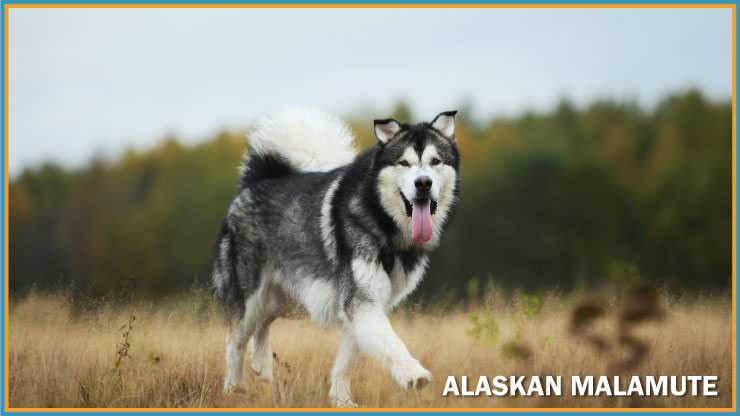
Alaskan Malamute vs. Siberian Husky: Can You Tell Them Apart?
In the last comparison blog, we discussed the Great Pyrenees vs. the Maremma Sheepdog. This time, we will understand the differences and similarities between two ancient Nordic dog breeds. It is the Alaskan Malamute versus the Siberian Husky!
BRIEF HISTORY OF THE ALASKAN MALAMUTE
Bred by the Mahlemut tribe, a nomadic Inuit tribe, the Alaskan Malamute breed is a native Alaskan arctic breed. The Alaskan Malamute dogs aided the Mahlemut people and were the key to the tribe’s survival. The Mahlemut people used these dogs to pull heavy cargo, but the dogs were also used for hunting seals and defending against polar bears. In the 19th century, during the Klondike Gold Rush, the breed almost went extinct. During that period, their dwindling numbers were due to the demand for sled dogs. Breeds like the Alaskan Malamute were bred with other dog breeds, producing mixed-breed dogs. Fortunately, due to the isolation of the Mahlemut tribe, their particular dogs remained pure, ultimately saving the breed.
A BRIEF HISTORY OF THE SIBERIAN HUSKY
Dogs of the nomadic Northeast Asian (Siberian) Chukchi tribes were used to develop the modern-day Siberian Husky breed. From these early ancestors came the Seppala Siberian Sleddog and the Siberian Husky breeds. These ancestors of the Siberian Husky were used routinely to travel long distances quickly. The Chukchi people’s land-locked lives depended on this travel to the sea for food and supplies.
Due to their ability to pull a sled for miles through frigid conditions, dogs of this type were imported by mushers/breeders in Alaska in the early 1900s. There, breeders continued breeding them to supply the demand for good sleddogs capable of transporting people and goods in subfreezing conditions. One of these breeders, Leonhard Seppala, won the All-Alaska sweepstakes three years (1915-1917) in a row with these rangy-looking imports from Russia. In 1925 when precious diphtheria serum was needed in the town of Nome, Alaska, Seppala and his team of 'Siberian Sleddogs' covered the most dangerous parts of the route, crossing the Norton Sound, contributing to the success of the Great Race of Mercy from Nenana to Nome in stopping an epidemic. It was from these noble sleddogs, known then as simply 'Seppalas,' that the Siberian Husky breed was developed. They remain an iconic breed due to their early history and unique markings.

SIMILARITIES
Many people recognize these breeds by their typical black and white coat colors. While these are the standard colors, there are others as well that the dogs share. The Alaskan Malamute can be various shades of the following: gray, black, sable, grizzle, and red. They may have varying colors and shades of their undercoat or agouti pattern, always with white points and underbody or solid white—all with a solidly marked mantle pattern and white restricted from the body. White “urajiro” points are the only white permissible. White facial masks and collars are permissible. For the Siberian Husky, all colors ranging from solid white to solid black are permissible. Black, gray, wolf, liver, various shades of sable, agouti, and chinchilla are also common. All with or without white points and markings.
Made to endure frigid climates, the Alaskan Malamute and the Siberian Husky have similar thick double coats. The Alaskan Malamute comes in two coat varieties: the standard and the long. The standard is a thick, plush, coarse outer coat that is short to medium in length. It is the longest on the neck, back, croup, breeches, and tail. The long coat variety is short on the face, forehead, and front of the forelimbs and hindlimbs. It is longer than the permissible two inches throughout, especially on the neck, ears, rear of the front and hindlimbs, feet, and tail, forming well-developed fringe and furnishings. The Siberian Husky coat is a double, medium-length coat with a straight, somewhat close-lying outer coat. A dense, soft undercoat supports the outer coat. The coat is never long, rough, silky, or standing off from the body.
DIFFERENCES
The easiest way to tell these two breeds apart is by their size difference. The Alaskan Malamute is significantly larger than the Siberian Husky. The Alaskan Malamute has a broader chest and overall stockier build. Males can weigh 85 to 124 pounds, while females weigh 75 to 124 pounds. Malamute males stand 25 to 28 inches tall and females 23 to 26 inches tall. That’s a lot of dog! The Siberian Husky is the leaner of the two with a less full-looking face and slightly longer body length than the Alaskan Malamute. The Siberian Husky is also lighter and smaller than the Malamutes - although they are still considered large dogs. Siberian Husky males weigh 45 to 60 pounds and stand 20 to 24 inches tall. The females weigh 35 to 50 pounds and stand 19 to 22 inches tall.

CONCLUSION
The Alaskan Malamute and the Siberian Husky were two dog breeds built for work. Both began as aids to the tribes that cared for and bred them. The Alaskan Malamute breed’s strength is undeniable as they fought and hunted alongside their people. The Siberian Husky breed’s lighter build and quickness helped their people get supplies and earn a place in history as descendants of Leonhard Seppala’s remarkable working dogs, which have survived to this day as the Seppala Siberian Sleddog.
Both breeds’ thick coats enabled them to endure the harsh climates where they worked. Those same coats make them two of the most recognizable breeds - even if telling the two apart might be tricky. These dogs are still utilized for their mushing sports and have a teamwork mindset, alertness, and intelligence. Their qualities make them perfect for an active family looking for a tough and loyal companion.
Click here for the complete Alaskan Malamute breed standard.
Click here for the complete Siberian Husky breed standard.










